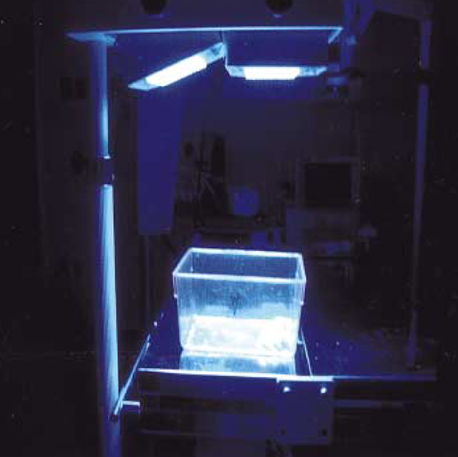J Korean Med Sci.
2005 Feb;20(1):61-64. 10.3346/jkms.2005.20.1.61.
In vitro and in vivo Efficacy of New Blue Light Emitting Diode Phototherapy Compared to Conventional Halogen Quartz Phototherapy for Neonatal Jaundice
- Affiliations
-
- 1Department of Pediatrics, Samsung Medical Center, Samsung Cheil Hospital, Sungkyunkwan University School of Medicine, Seoul, Korea. mhlee@smc.samsung.co.kr
- 2Department of Biomedical, Samsung Medical Center, Samsung Cheil Hospital, Sungkyunkwan University School of Medicine, Seoul, Korea.
- 3Department of Engineering, Samsung Medical Center, Samsung Cheil Hospital, Sungkyunkwan University School of Medicine, Seoul, Korea.
- KMID: 1781726
- DOI: http://doi.org/10.3346/jkms.2005.20.1.61
Abstract
- High intensity light emitting diodes (LEDs) are being studied as possible light sources for the phototherapy of neonatal jaundice, as they can emit high intensity light of narrow wavelength band in the blue region of the visible light spectrum corresponding to the spectrum of maximal bilirubin absorption. We developed a prototype blue gallium nitride LED phototherapy unit with high intensity, and compared its efficacy to commercially used halogen quartz phototherapy device by measuring both in vitro and in vivo bilirubin photodegradation. The prototype device with two focused arrays, each with 500 blue LEDs, generated greater irradiance than the conventional device tested. The LED device showed a significantly higher efficacy of bilirubin photodegradation than the conventional phototherapy in both in vitro experiment using microhematocrit tubes (44 +/-7% vs. 35 +/-2%) and in vivo experiment using Gunn rats (30 +/-9% vs. 16 +/-8%). We conclude that high intensity blue LED device was much more effective than conventional phototherapy of both in vitro and in vivo bilirubin photodegradation. Further studies will be necessary to prove its clinical efficacy.
Keyword
MeSH Terms
Figure
Reference
-
1. McDonagh AF. Phototherapy: from ancient Egypt to the new millennium. J Perinatol. 2001. 21:Suppl 1. S7–S12.
Article2. Maisels MJ. Phototherapy-traditional and nontraditional. J Perinatol. 2001. 21:Suppl 1. S93–S97.3. Hansen TW. Phototherapy for neonatal jaundice-still in need of fine tuning. Acta Paediatr. 2000. 89:770–772.
Article4. Maisels MJ. Why use homeopathic doses of phototherapy? Pediatrics. 1996. 98:283–287.5. Tan KL. The nature of the dose-response relationship of phototherapy for neonatal hyperbilirubinemia. J Pediatr. 1977. 90:448–452.
Article6. Modi N, Keay AJ. Phototherapy for neonatal hyperbilirubinemia: The importance of does. Arch Dis Child. 1983. 58:406–409.7. Ente G, Klein SW. Hazards of phototherapy. N Engl J Med. 1970. 283:544–545.
Article8. Christensen T, Reitan JB, Kinn G. Single-strand breaks in the DNA of human cells exposed to visible light from phototherapy lamps in the presence and absence of bilirubin. J Photochem Photobiol B. 1990. 7:337–346.
Article9. Kang JH, Shankaran S. Double phototherapy with high irradiance compared with single phototherapy in neonates with hyperbilirubinemia. Am J Perinatol. 1995. 12:178–180.
Article10. Hansen TW. Acute management of extreme neonatal jaundice-the potential benefits of intensified phototherapy and interruption of enterohepatic circulation. Acta Paediatr. 1997. 86:843–846.11. Tan KL, Lim GC, Boey KW. Efficacy of high intensity blue light and standard daylight phototherapy for non-haemolytic hyperbilirubinemia. Acta Paediatr. 1992. 81:870–874.12. Nakamura S, Fasol G. InGaN single-quantum-well LEDs. The Blue Laser Diode. 1997. Berlin: Springer-Verlag;201–221.
Article13. Fasol G. Longer life for the blue laser. Science. 1997. 278:1902–1903.14. Vreman HJ, Wong RJ, Stevenson DK, Route RK, Reader SD, Fejer MM, Gale R, Seidman DS. Light-emitting diodes: A novel light source for phototherapy. Pediatr Res. 1998. 44:804–809.
Article15. Ennever JF, McDonagh AF, Speck WT. Phototherapy for neonatal jaundice: Optimal wavelengths of light. J Pediatr. 1983. 103:295–299.
Article16. Ennever J. Blue light, green light, white light, more light: Treatment of neonatal jaundice. Clin Perinatol. 1990. 17:467–481.
Article17. Seidman DS, Moise J, Ergaz Z, Laor A, Vreman HJ, Stevenson DK, Gale R. A prospective randomized controlled study of phototherapy using blue and blue-green light-emitting devices, and conventional halogen-quartz phototherapy. J Perinatol. 2003. 23:123–127.
Article18. Seidman DS, Moise J, Ergaz Z, Laor A, Vreman HJ, Stevenson DK, Gale R. A new blue light-emitting phototherapy device: a prospective randomized controlled study. J Pediatr. 2000. 136:771–774.
Article19. Tan KL. The pattern of bilirubin response to phototherapy for neonatal hyperbilirubinaemia. Pediatr Res. 1982. 16:670–674.
Article
- Full Text Links
- Actions
-
Cited
- CITED
-
- Close
- Share
- Similar articles
-
- The Effect of 650 nm Red Light Phototherapy on Acne Vulgaris
- A Pilot Comparative Study of Alternating Blue and Red Light LED Phototherapy and Pulsed-dye Laser Therapy for Acne Vulgaris Treatment
- Transfer printing based manufacturing process for flexible micro-light emitting diode phototherapy devices
- Guidelines on the serum bilirubin concentration for the management of neonatal jaundice and controlled clinical trial of phenobarbital and or phototherapy in reducing neonatal hyperbili-rubinemia
- The Effect of Blue Light and White Light, Continous and Intermittent Phototherapy in the Treatment of Jaundice for the Low Birth Weight Infants



